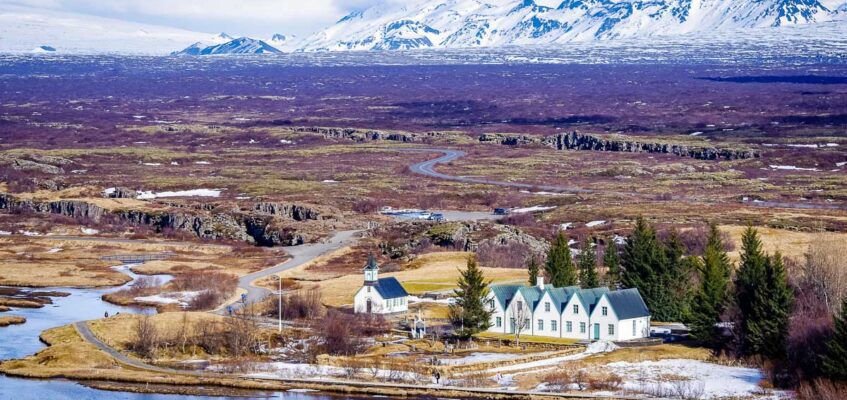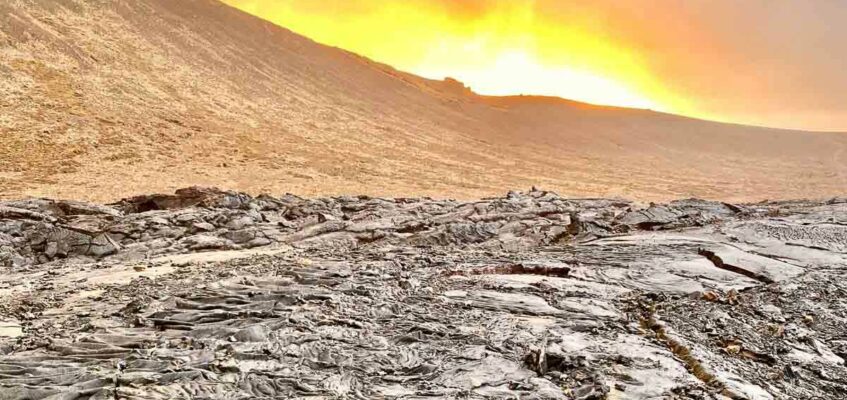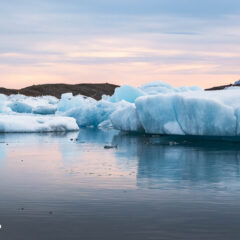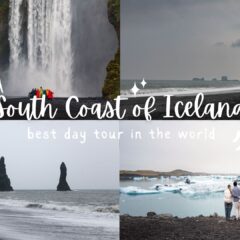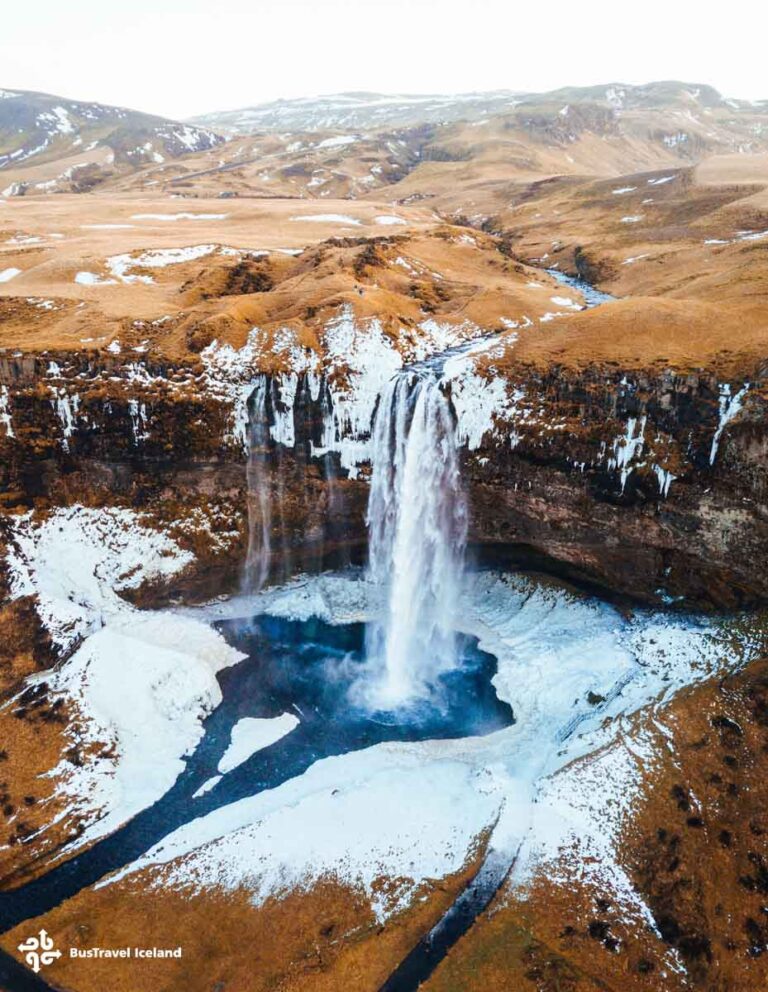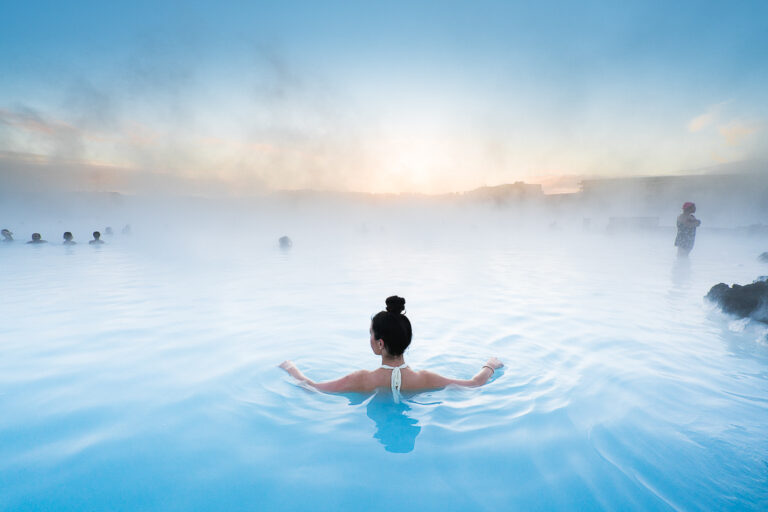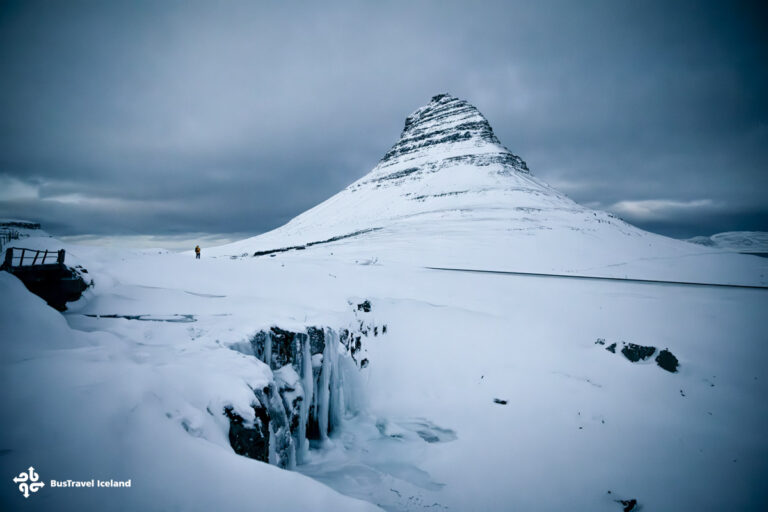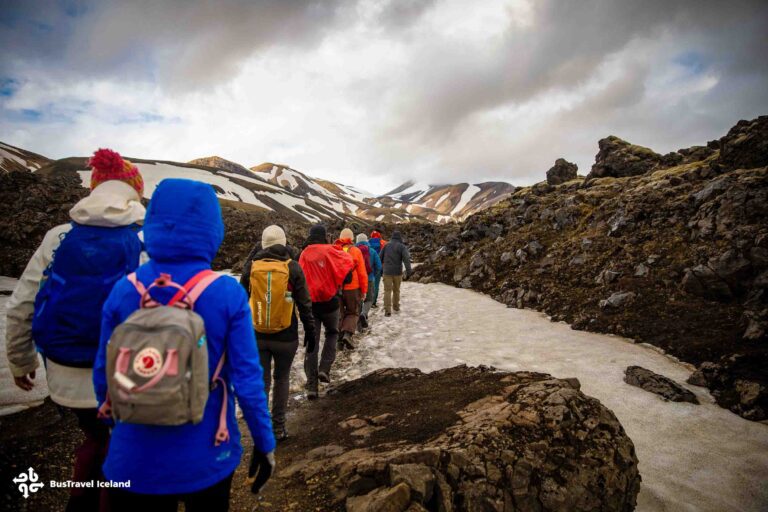Discover Vestrahorn – The Dramatic Mountain of East Iceland
- East Iceland
- 6 Apr 2025
If you’re searching for that one place in Iceland that feels untouched, almost otherworldly, and still somehow under the radar—Vestrahorn is your dream come true.
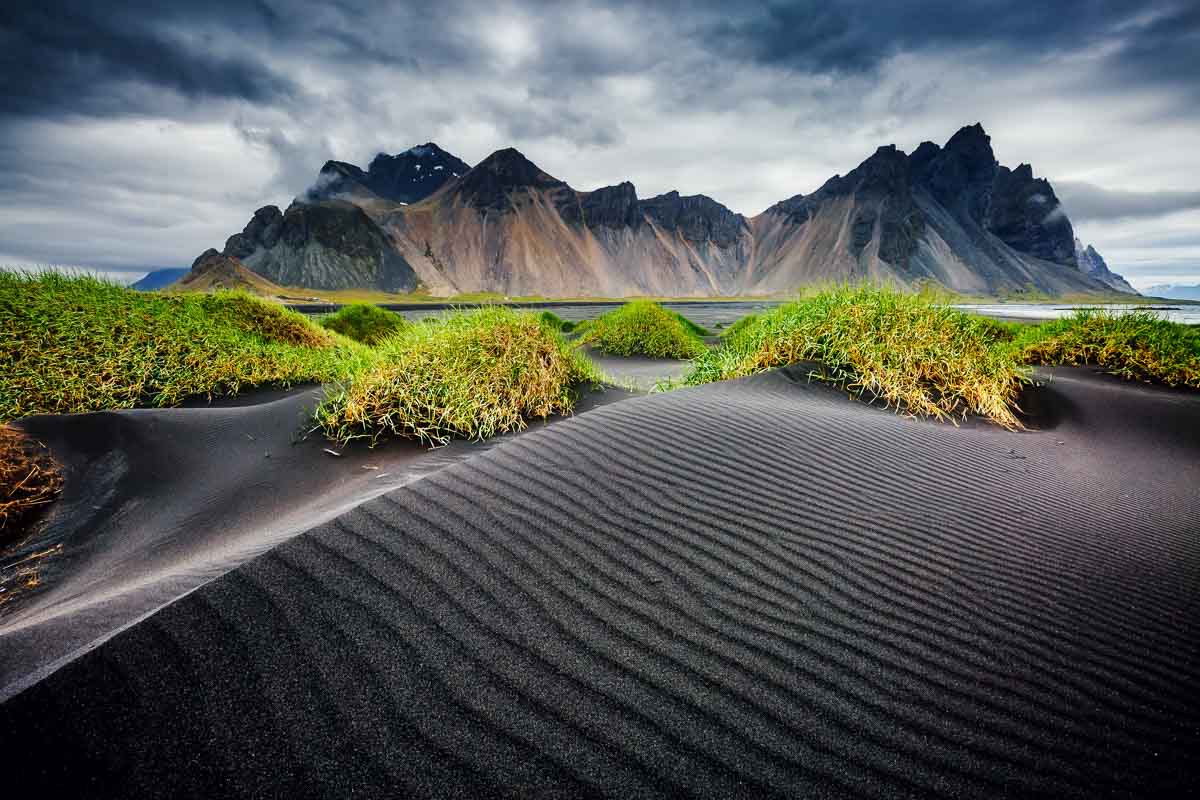
Located near the Stokksnes Peninsula on Iceland’s lesser-traveled eastern coast, Vestrahorn is a 454-meter (1,490 feet) mountain of jagged peaks, brooding rock faces, and moody skies that constantly shift with the weather. It’s the kind of place where you’ll want to sit in silence just to take it all in—and then immediately reach for your camera.
Where is the Vestrahorn Mountain
Vestrahorn Mountain is located on the Stokksnes Peninsula in southeast Iceland, near the town of Höfn in the Eastfjords region. It sits along the Ring Road (Route 1) but requires a short detour onto a private access road.
The 454-meter high mountain is bordered by a striking black sand beach, rolling grass-topped sand dunes, and a tidal lagoon that often mirrors its jagged peaks in calm weather. These unique dunes—contrasting vibrant green tufts against the dark volcanic sand—create a surreal, otherworldly landscape that is especially popular with photographers.
How To Get To Vestrahron
Vestrahorn Mountain is located just about 12 kilometers (7.5 miles) from the town of Höfn in southeast Iceland, making it an easy 15-minute drive.
To get there, you’ll head east on Route 1 (the Ring Road) and look for an unmarked gravel road on your right after roughly 9 kilometers—just before reaching a tunnel. This access road leads to the Stokksnes Peninsula, home to Vestrahorn.
After a short drive of about 3 kilometers, you’ll arrive at the Viking Cafe, where visitors must pay a small entrance fee, as the area is situated on private land.
Once you’ve checked in at the café, you can continue driving a short distance to the designated parking area near the black sand beach, with stunning views of Vestrahorn’s jagged peaks.
The access road is usually in good condition and suitable for standard vehicles, though always check weather conditions before you go. It’s best to verify the Viking Café’s opening hours ahead of time to ensure you can get access when you arrive.
The Iconic View of Vestrahorn, Brunnhorn, and Eystrahorn
When you approach the Stokksnes Peninsula, the sight that unfolds before you is nothing short of breathtaking. The towering, jagged peaks of Vestrahorn, Brunnhorn, and Eystrahorn form an iconic mountain trio that rises dramatically from the rugged Icelandic landscape. Together, these mountains create one of the most stunning vistas in all of Iceland.
Vestrahorn, the tallest and most well-known of the three, dominates the scene with its sharp, rugged slopes. Standing 454 meters (1,490 feet) tall, it looks as though it’s been carved from the earth’s very core. Often reflected in the calm waters of the lagoon at its base, Vestrahorn’s otherworldly beauty makes it a photographer’s dream, with its jagged peaks and wild terrain.
To the right of Vestrahorn lies Brunnhorn, which is affectionately called the “Batman Mountain” due to its distinctive three peaks that resemble the famous logo. These unique features make Brunnhorn stand out, adding an element of whimsy and drama to the landscape. While it shares some similar features with Vestrahorn, its shape and form give it a character all its own.
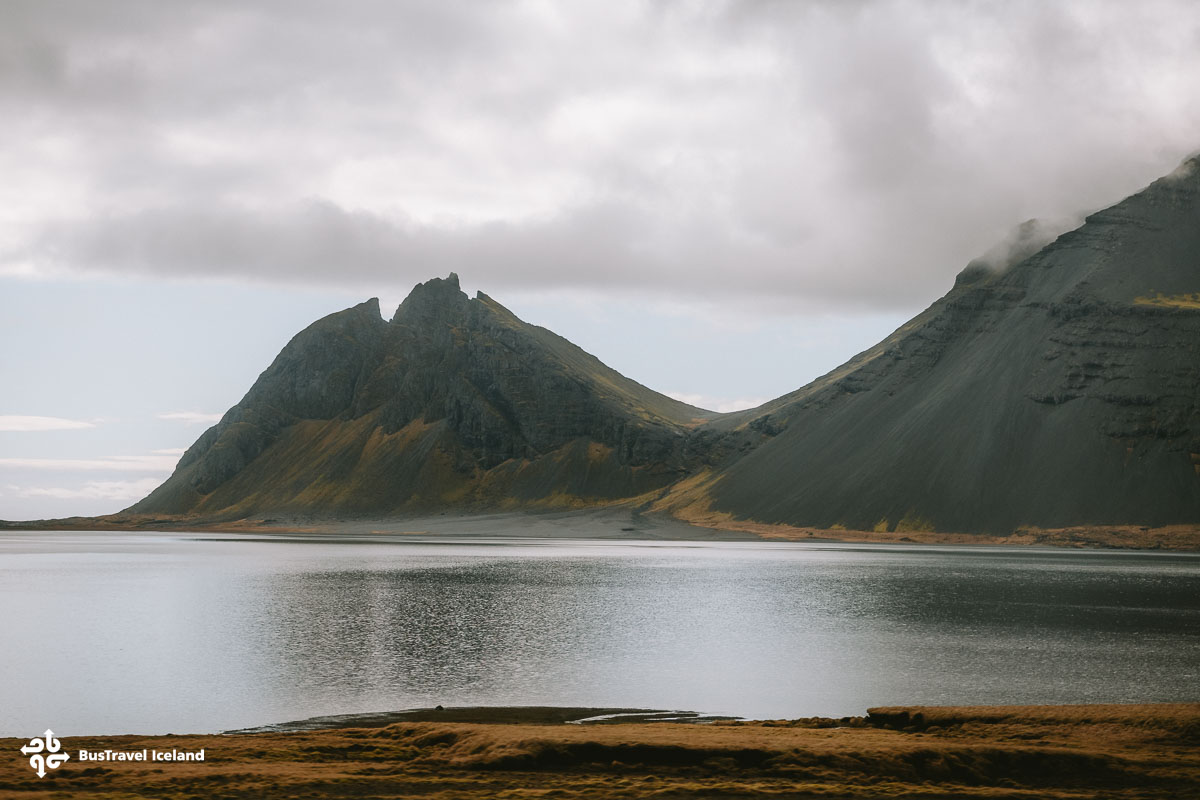
Further along the peninsula is Eystrahorn, a majestic mountain that rises to 756 meters (2,477 feet). Eystrahorn is often a bit quieter and less visited than Vestrahorn, but its beauty is equally striking. The mountain’s stark, dark slopes and rugged ridgelines offer a perfect contrast to the sweeping black sand beaches and green grass dunes at its feet. Eystrahorn feels remote and untouched, making it a peaceful, almost mystical sight.
Together, these three peaks—Vestrahorn, Brunnhorn, and Eystrahorn—frame one of the most iconic and picturesque views in Iceland. Surrounded by the black sand beach, grassy dunes, and a sometimes-swirling mist, the landscape looks like a scene pulled from the pages of a fantasy novel. Whether you’re photographing the scene, hiking the surrounding area, or simply taking it all in, this trio of mountains provides an unforgettable experience in one of Iceland’s most awe-inspiring corners.
How Mountain Vestrahorn Was Formed
The Vestrahorn area isn’t just visually stunning—it’s geologically fascinating. These mountains are part of some of the oldest formations in Iceland, dating back 8–11 million years to the Tertiary Period, long before much of the rest of the island was formed.
Unlike many of Iceland’s volcanic peaks, which are made of basalt and formed more recently from surface lava flows, Vestrahorn is composed primarily of gabbro and granophyre—two types of intrusive igneous rock. These rocks formed deep underground from slowly cooled magma and were later exposed through uplift and erosion. Gabbro rock is coarse-grained and dark, giving Vestrahorn its deep, shadowy tones, while granophyre is lighter and often seen in bands or veins running through the rock. This unique combination gives the mountain its dramatic texture and strikingly rugged appearance.
Brunnhorn and Eystrahorn share a similar geological makeup. Eystrahorn, in particular, is known for its sharp ridgelines and is part of the Krossanesfjall mountain range. Interestingly, traces of gold, silver, and mercury have been found in the area, hinting at a complex volcanic and mineral-rich history beneath the surface.
The surrounding black sand beaches and dune systems are composed mostly of volcanic ash and finely ground lava rock, shaped over time by glacial activity, wind, and ocean waves. These contrast beautifully with the grassy mounds and pebbled shoreline, making the landscape as scientifically intriguing as it is visually compelling.
The area also showcases classic signs of glacial erosion, with sharp peaks and U-shaped valleys carved over millennia by moving ice. When you stand in front of these mountains, you’re not just seeing a beautiful scene—you’re witnessing the result of millions of years of geological forces, from deep volcanic activity to the grinding power of glaciers.
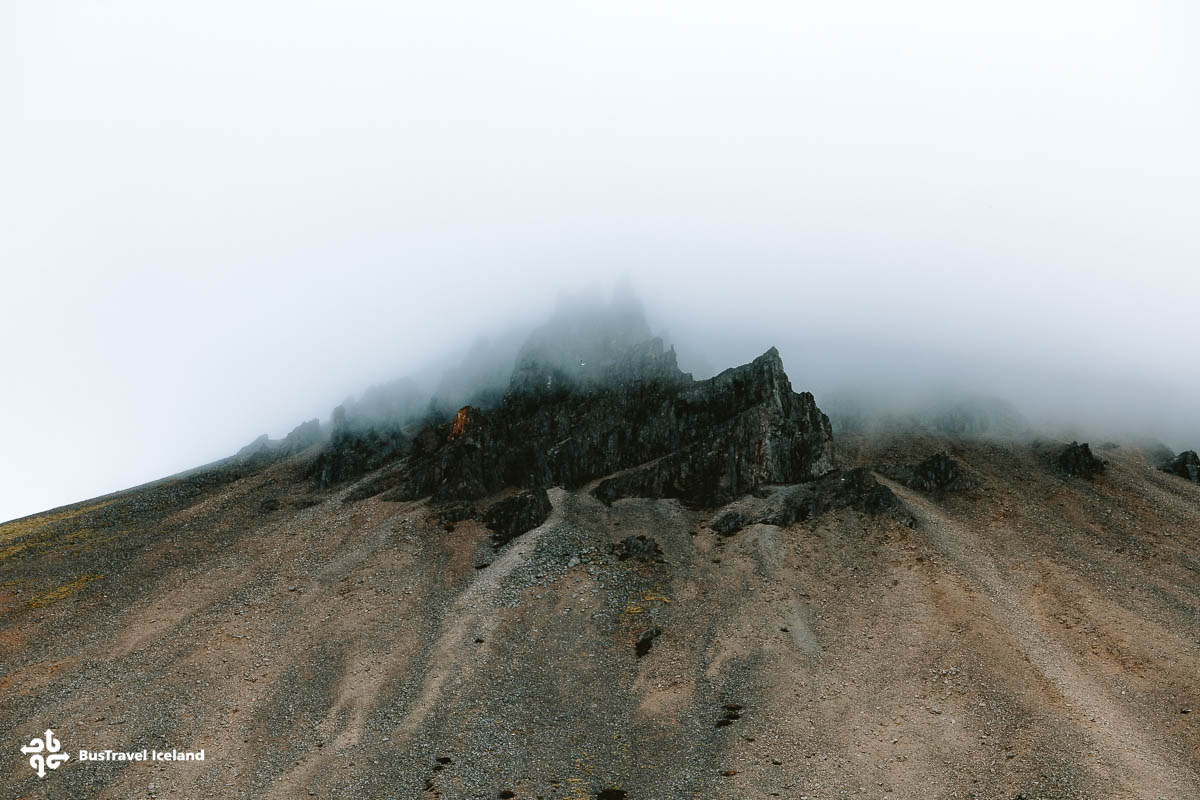
Hiking Around Mountain Vestrahorn
Yes, you can hike the marked trails in the Vestrahorn area, which offers several hike trails catering to different skill levels. While the mountain itself presents challenging terrain, there are marked paths around it that provide stunning views and unique experiences.
- Yellow Path: This 5.5 km (3.4 miles) trail is considered easy and takes you along the black sand beach of Vestrahorn, passing by the Viking Village—a replica film set used in productions like “The Witcher.” It’s a popular route for birding, camping, and hiking, typically taking about 1.5 hours to complete.
- Red Path: A 5.1 km (3.2 miles) easy trail that guides you around the western part of the black sands, including a walk along the rocky edge of the Atlantic Coast. Along this route, you can observe vibrant birdlife, seals in the sea, and the Stokksnes Lighthouse.
- Blue Path: This is the most challenging trail, extending 7.4 km (4.6 miles) and requiring some hiking experience and good footwear. It takes you around the mountain of Vestrahorn, involving steep ascents and descents, with sections that may require bouldering and navigating scree slopes. It’s advisable to consult with the Viking Café for current conditions before attempting this path.
While these trails offer immersive experiences around Vestrahorn in Iceland, ascending the mountain itself is not a common activity due to its steep and rugged nature. The surrounding trails, however, provide ample opportunities to appreciate the area’s dramatic landscapes.
Before embarking on any hike, it’s recommended to check in at the Viking Café for maps, trail conditions, and any necessary permissions, as the area is privately owned and requires an entrance fee.
Always ensure you’re equipped with appropriate gear and check weather conditions, as Icelandic weather can be unpredictable.
Please take the map for your reference.
Taking Photos in the Vestrahorn Area
From a photographer’s point of view, Vestrahorn is a landscape that truly delivers. It’s not just another scenic stop—it’s a location that demands creative attention and rewards you with jaw-dropping imagery. One of the most photographed mountains in Iceland, with its brooding mountain ridges, mirror-like reflections, windswept black sands, and ever-changing Icelandic skies, Vestrahorn offers a rich canvas for both minimalist compositions and dramatic storytelling.
Golden Hours & Light Play
One of the best times to shoot is during the golden hour, especially at sunrise. The low-angle light paints the peaks of Vestrahorn in soft oranges and pinks, creating rich contrast with the dark volcanic terrain. Because the mountain faces east, sunrise provides the most direct and flattering light on the ridges. That said, sunset can also be magical, casting long shadows across the dunes and igniting the clouds over the Atlantic.
In the winter months, low-hanging sun and extended twilight hours give you a broader shooting window with incredible diffused light—perfect for moody, cinematic compositions. In summertime, the midnight sun offers a completely different but equally stunning experience.
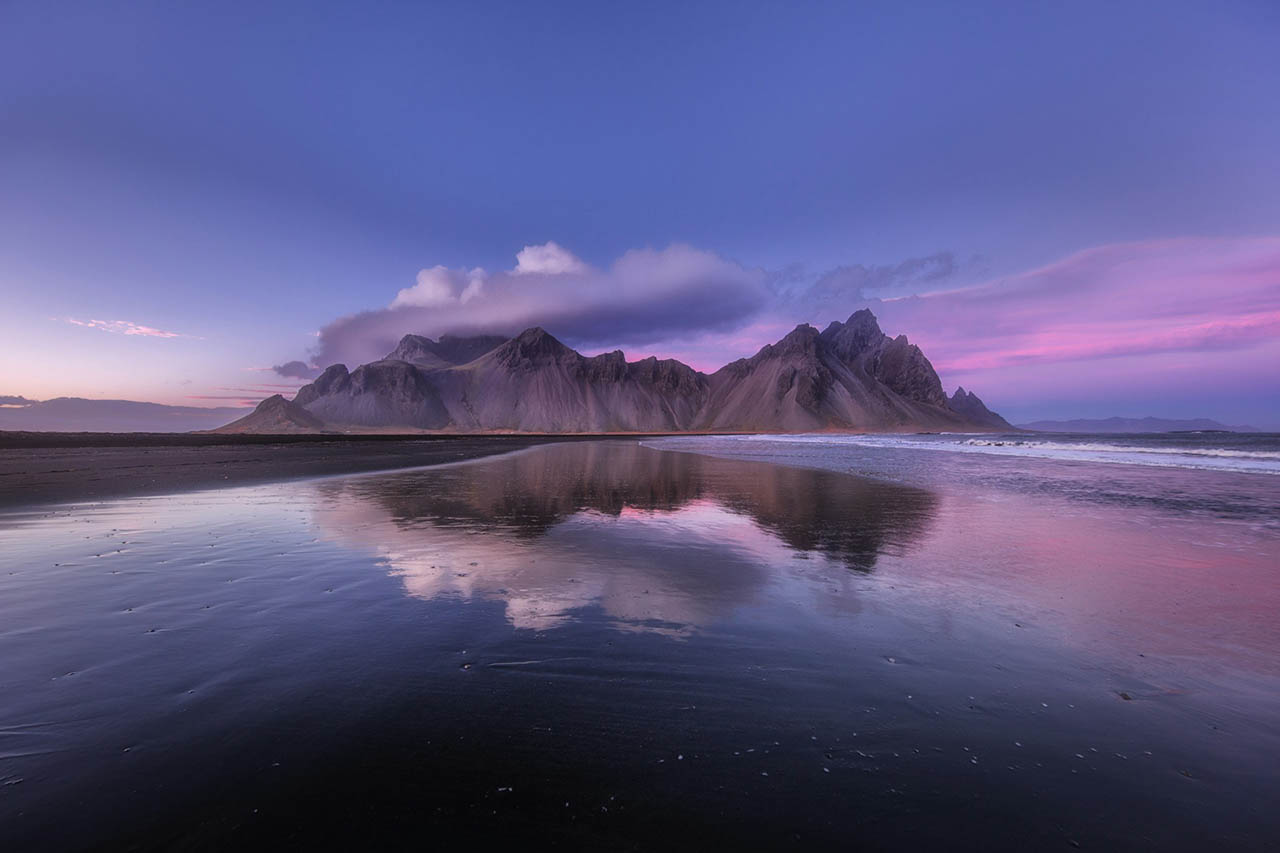
Northern Lights – Aurora Over Vestrahorn
Perhaps the most coveted shot of all is capturing the Aurora Borealis dancing over Vestrahorn. With its remote location, minimal light pollution, and wide open views, the Stokksnes Peninsula is one of the best spots in Iceland to witness and photograph the northern lights. The dramatic silhouette of Vestrahorn provides a powerful foreground against the swirling green and purple ribbons of light in the sky.
For the best results:
- Visit between September and April, when the nights are darkest.
- Use a tripod, wide-aperture lens (f/2.8 or faster), and long exposure settings (5–20 seconds depending on aurora strength).
- Include the lagoon or dunes in your composition for extra depth and texture.
Arrive early to scout your foreground and monitor aurora forecasts (like Vedur or Aurora Alerts).
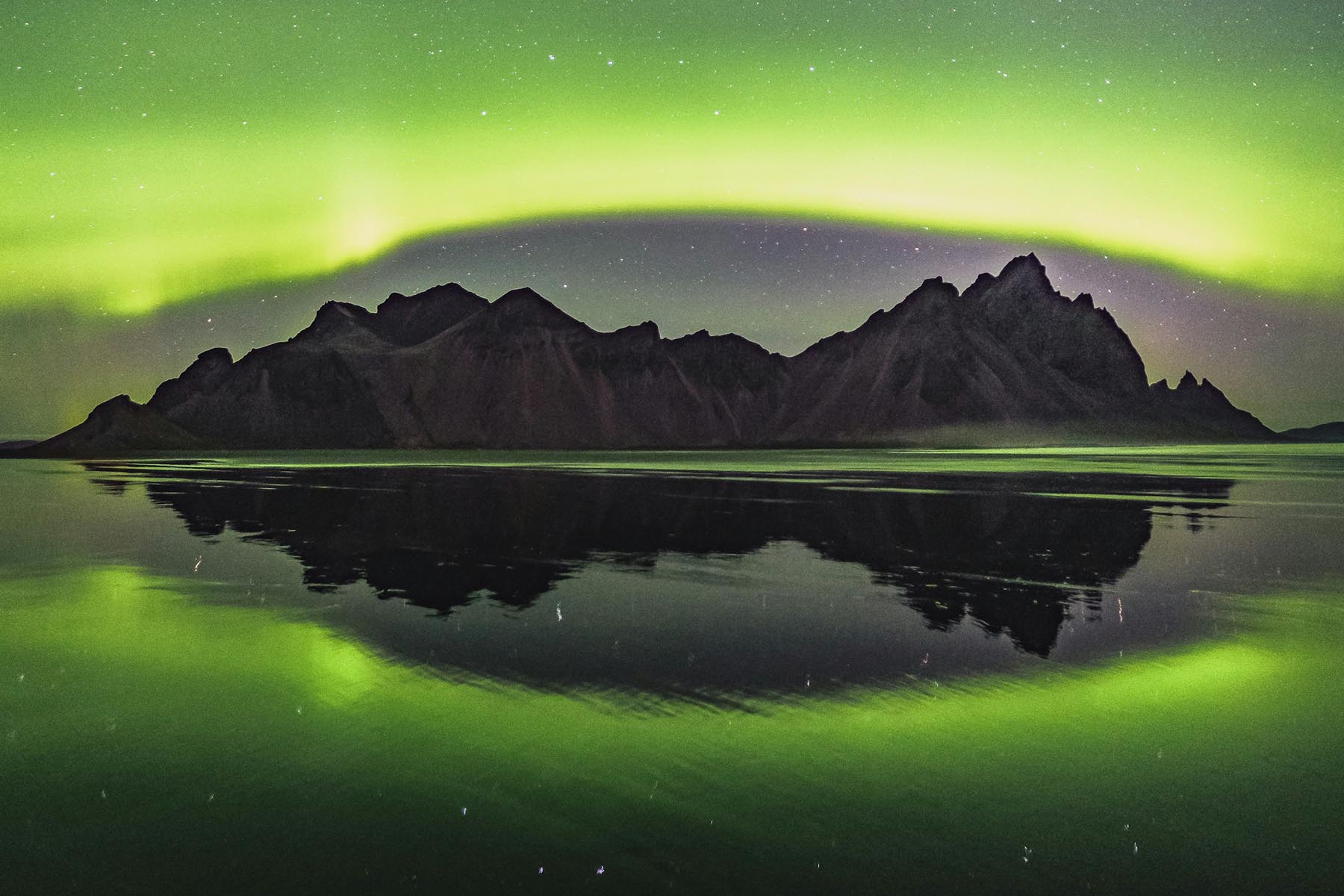
Reflections & Foregrounds
The shallow tidal lagoon at the base of the mountain is one of the key elements to include in your shots. On still days, it provides an almost perfect mirror reflection of the jagged peaks, creating symmetry and surreal beauty. This is especially effective with a wide-angle lens (16–35mm range) to capture both the reflection and the expansive skies.
The grass-tufted black sand dunes add a strong foreground element and are ideal for leading lines and texture. Positioning the dunes in the foreground with Vestrahorn towering in the background creates depth and interest in your composition.
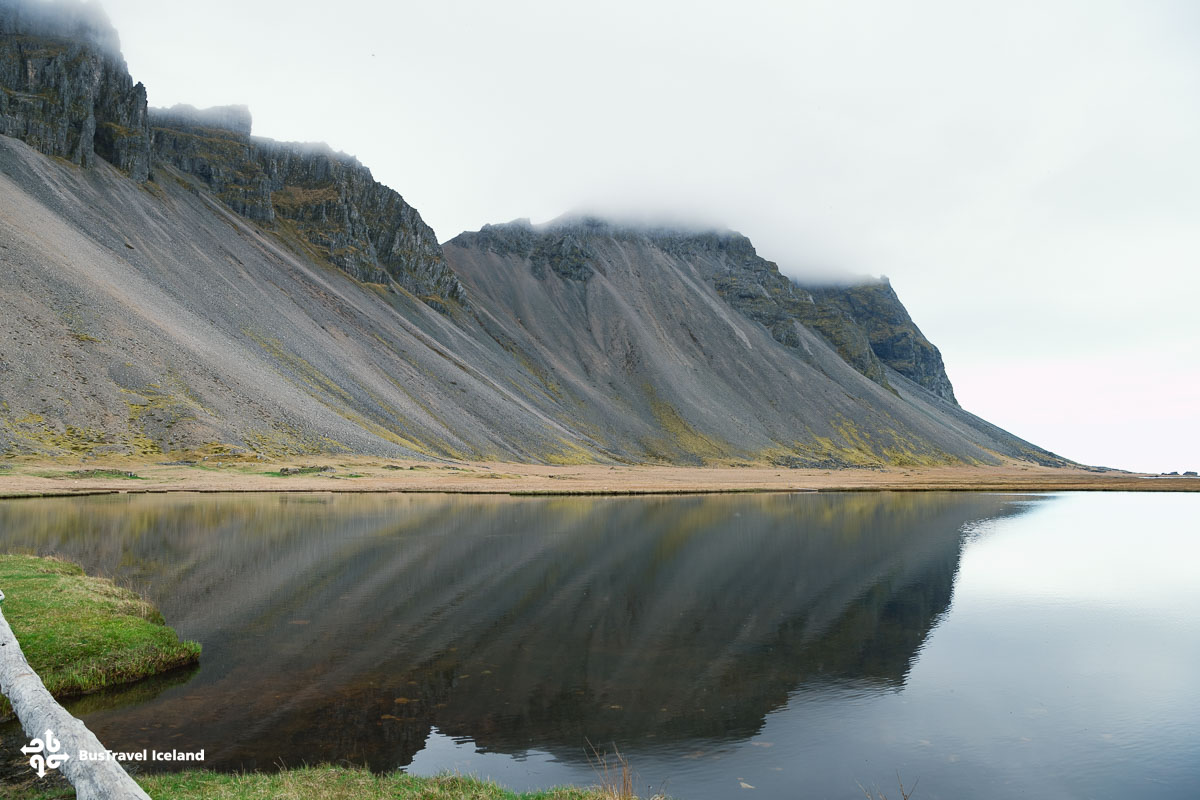
Weather & Atmosphere
Don’t let a cloudy or stormy forecast keep you away—mood is everything here. Vestrahorn wears clouds and mist like a crown. Dramatic skies, rolling fog, and sudden shafts of light can turn a good shot into a great one. The mountain transforms constantly, so patience is often rewarded.
Moody Overcast Skies
Overcast conditions create an ethereal, almost monochrome effect over the mountain. The textures of the rock come alive under soft, diffused light, and the lack of shadows makes it easier to capture every crag and ridge. These conditions are perfect for black and white photography, long exposures, and minimalistic compositions with the dunes and shoreline.
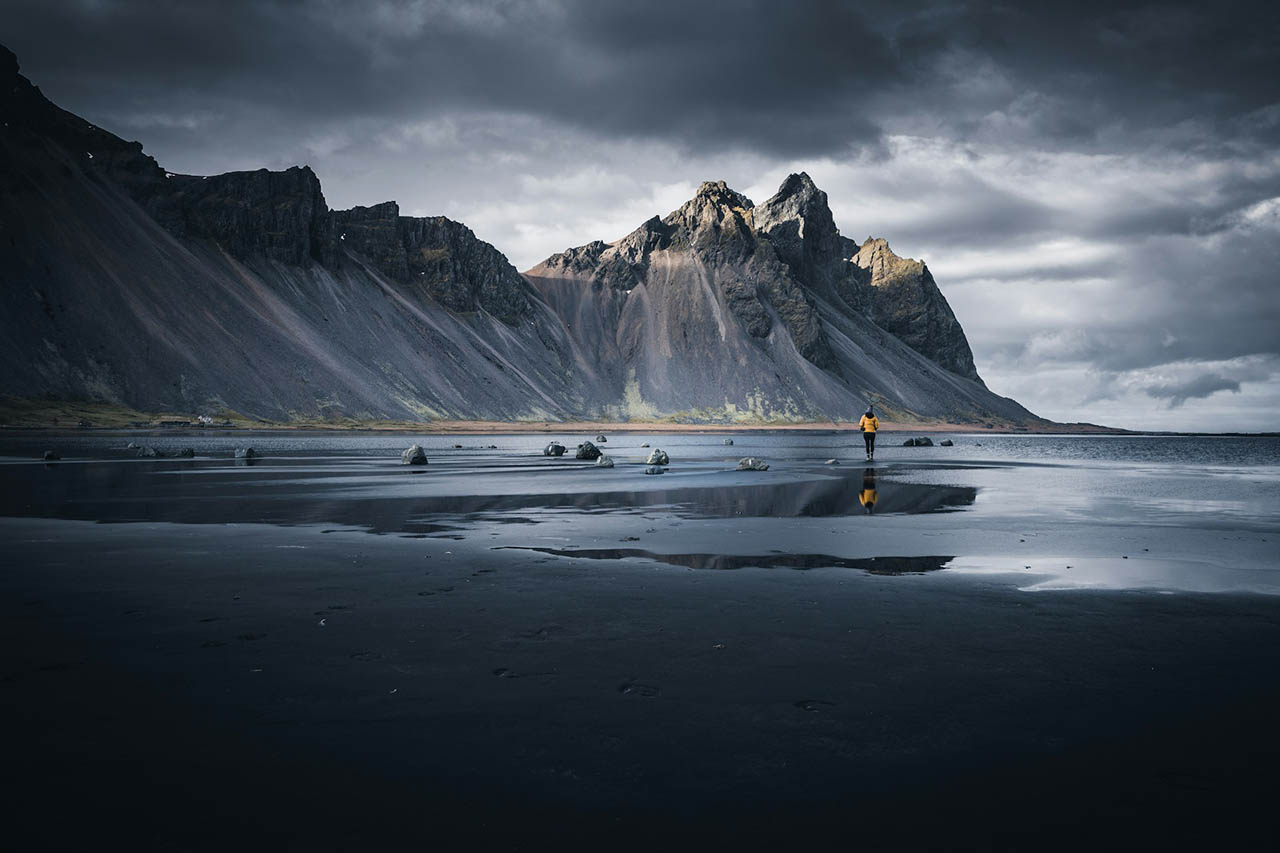
Fog and Mist
When fog rolls in from the Atlantic or mist clings to the base of the mountain, Vestrahorn becomes mystical and otherworldly. The peaks may appear and disappear in layers, giving a ghostly silhouette effect that changes by the minute. Misty conditions are ideal for storytelling shots and soft-focus drama—use a telephoto lens to compress layers of mountain and fog for atmospheric results.
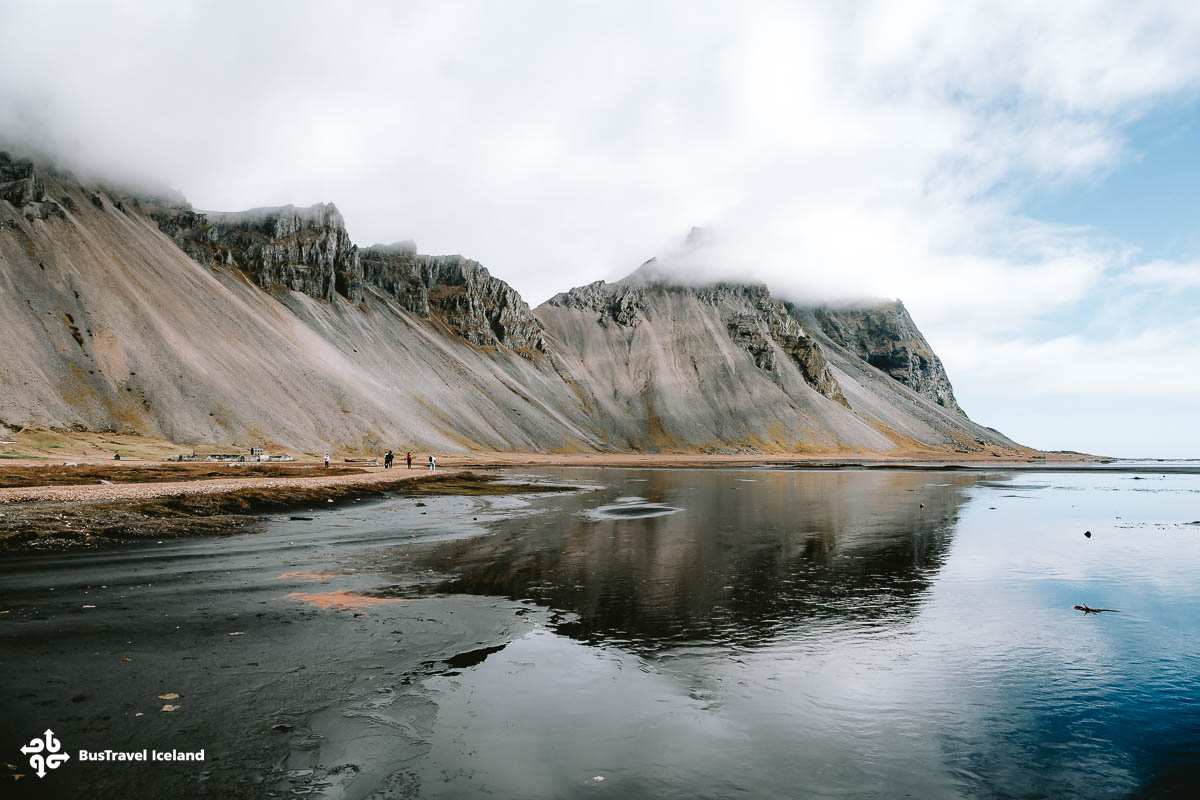
Clear Skies and Reflections
On calm, clear days—especially after rain—the tidal pools and lagoon at the base of Vestrahorn act like a perfect mirror. This is the time to frame those iconic reflection shots, ideally during the golden hour when the mountain glows and the beach is bathed in warm tones. The contrast between the crisp blue sky and black sand is also visually striking.

Stormy Weather and Wind
High winds can whip up sand and sea spray, creating dynamic textures in the sky and on the ground. Stormy skies often bring dramatic cloud formations and sudden light breaks—perfect for dramatic, high-contrast images. Just be sure to protect your gear, especially on windblown dunes where fine sand can get into your camera body or lens mechanisms.

Snow and Winter Light
In the winter months, Vestrahorn is often dusted with snow, emphasizing its ridges and giving the scene a high-contrast, arctic look. The low winter sun creates soft golden light that lingers, and the mountain takes on a glowing quality that’s hard to replicate elsewhere. Pair that with a sky full of northern lights, and you have one of the most powerful winter landscapes to photograph in all of Iceland.
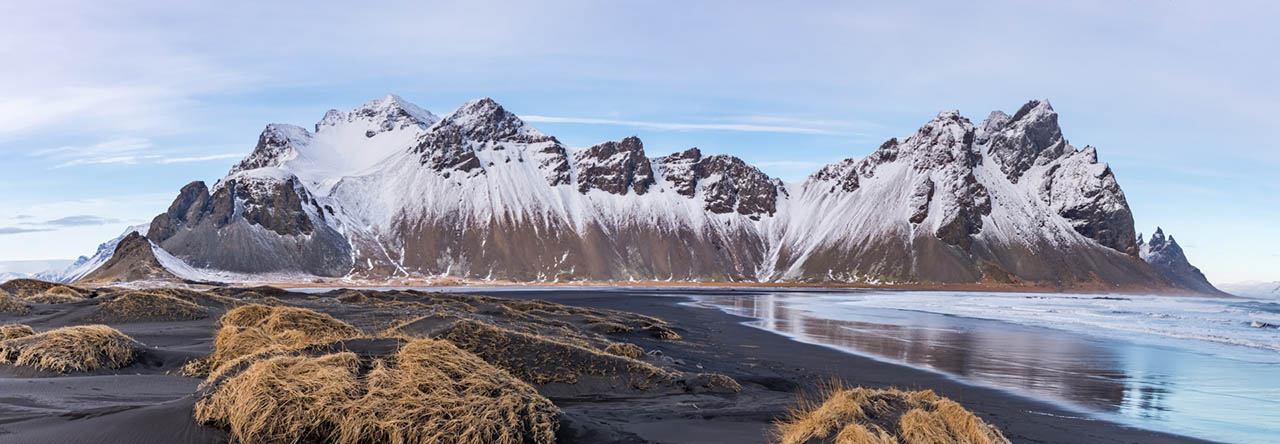
Viking Village & Other Subjects
Just a short walk from the beach is the Viking Village, a reconstructed film set that offers rustic textures and medieval charm. While it’s a bit kitschy, it can add variety to your shoot, especially for storytelling or editorial-style photography.
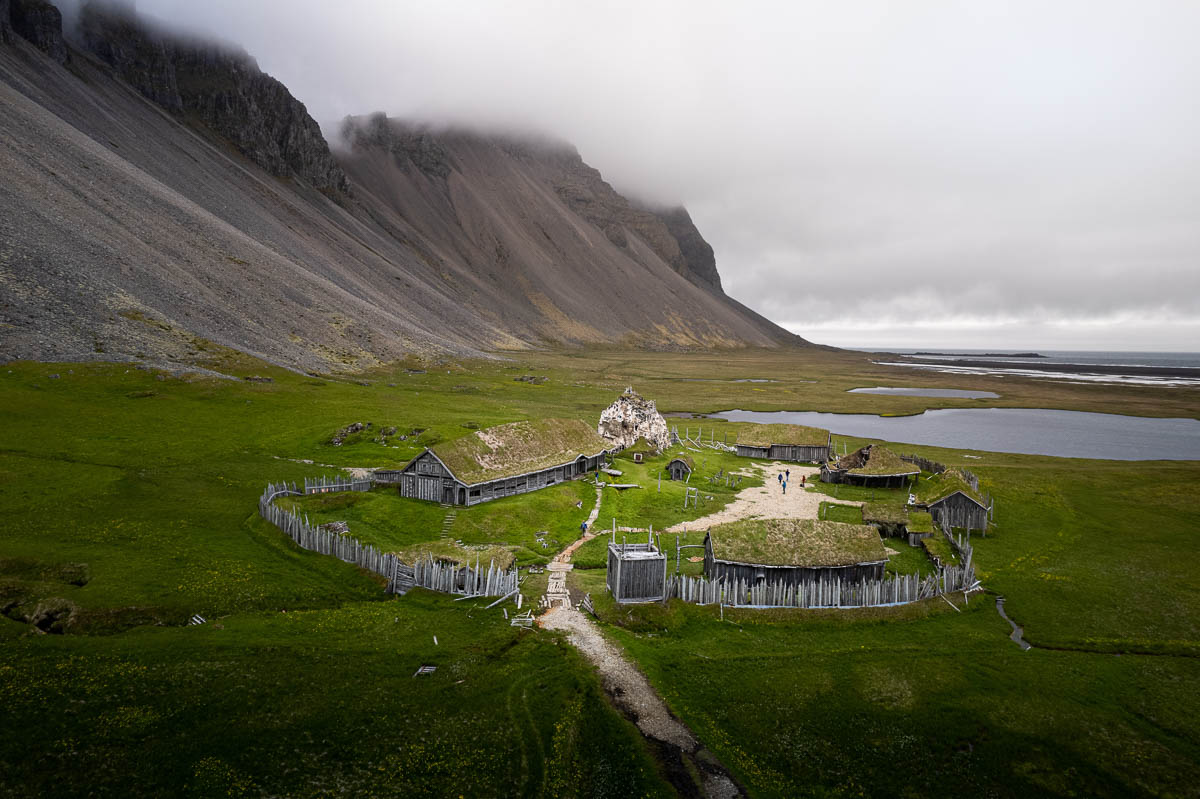
Best Photo Spots Around Vestrahorn
When the tide rolls in at Stokksnes, the ocean quietly spills over the black sands beneath Vestrahorn, creating a delicate, glass-like lagoon known as Kirkjusandur. On those rare, tranquil days when the wind takes a break, this shallow stretch becomes a stunning natural mirror—offering photographers the chance to capture dreamlike reflections of the mountain’s dramatic peaks.
That said, calm weather in Iceland is more of a treat than a given. The wind is almost a permanent feature of the landscape—it’s just a matter of whether it’s gently breezing or trying to steal your tripod. But don’t be discouraged! Even if the surface isn’t still enough for perfect reflections, there are other creative ways to use the lagoon.
One especially striking idea is to photograph or film a subject walking through the shallow water, heading toward the mountain. Because the lagoon is so shallow, you can often walk across it without getting soaked—assuming you’ve got decent boots. From the right angle, it creates the illusion of someone walking on water, adding a surreal, cinematic feel to your composition.
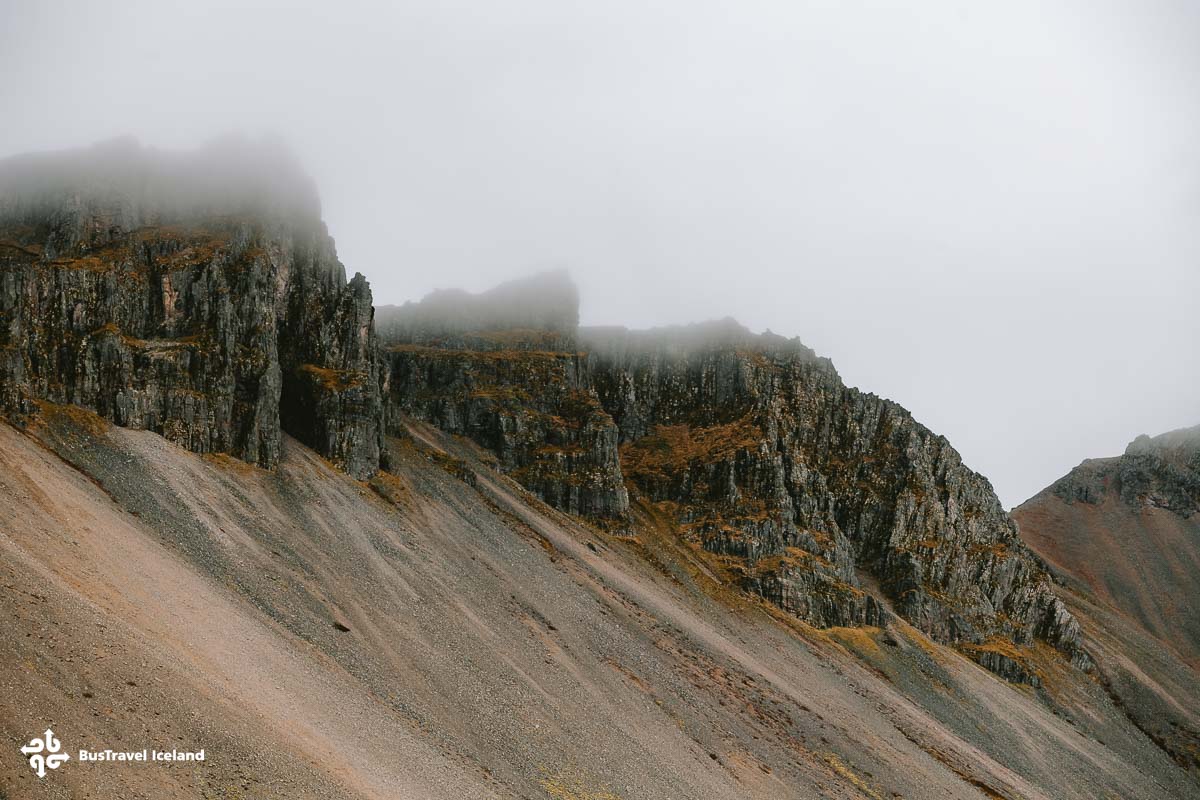
Final Photography Tip
Be prepared to wait and wander. Some of the best shots come between the obvious spots—on the dune ridges, behind the pools, or at odd angles where the light hits just right. Vestrahorn is a place to slow down, observe, and really connect with the landscape—whether it’s bathed in golden light or glowing beneath the northern lights.
How Much Time Do You Need at Vestrahorn
How Much Time Do You Need at Vestrahorn
For most visitors, 2 to 3 hours is a good amount of time to explore and enjoy Vestrahorn at a relaxed pace. This gives you enough time to:
- Walk along the black sand beach
- Photograph the mountain and lagoon from multiple angles
- Wander through the grass-covered dunes
- Visit the Viking Village film set
- Soak in the scenery (and maybe catch a moment of still reflection in the water)
However, if you’re a photographer or nature enthusiast, you might want to spend 4–5 hours or even return more than once to capture different lighting conditions—especially if you’re aiming for sunrise, sunset, or northern lights shots.
If you’re doing a quick stop while driving the Ring Road, you can still experience the essence of Vestrahorn in about an hour, but it might feel rushed, especially if you want to explore beyond just the main viewpoint.
And if the weather is wild? You may want to linger and watch it change—because in Iceland, a stormy sky can become golden light in 20 minutes.
Why Visit Vestrahorn
Vestrahorn isn’t just a pretty backdrop—it’s an experience. Its jagged silhouette rising from black sands creates some of the most cinematic views in Iceland. On calm days, the tidal pools at its base act like mirrors, perfectly reflecting the mountain’s sharp ridges and moody skies. Whether bathed in the golden glow of sunrise or veiled in mist, the scene feels almost otherworldly.
One of the best parts? The solitude. Unlike the busy stops along the Golden Circle or even the popular Jökulsárlón Glacier Lagoon, Vestrahorn is often quiet—peacefully so. You might find yourself standing alone on the beach, just you, the wind, and the raw beauty of the Icelandic landscape.
There’s more than scenery here too. Seals sometimes sun themselves along the shoreline, and just a short walk away, you’ll stumble upon a quirky Viking village film set—originally built for a movie that never happened. Weathered by the elements, it now adds an eerie, atmospheric touch that makes the place feel even more like a scene out of a Norse legend.
Nearby Attractions to Explore Around Vestrahorn
While Vestrahorn is a standout destination on its own, the surrounding southeast region is rich with incredible sights that make the journey even more rewarding.
Just a 15-minute drive north is the cozy fishing town of Höfn, known for its glacier views and delicious langoustine dishes. It’s a great place to grab a bite, stretch your legs along the harbor, or even book a boat tour for a closer look at the Vatnajökull glacier tongues.
Heading west for about an hour along the South Coast of Iceland, you’ll reach the breathtaking Jökulsárlón Glacier Lagoon, where massive blue icebergs float silently across icy waters. Right nearby is the stunning Diamond Beach, where glittering ice shards wash ashore on black sand—a surreal and mesmerizing sight for photographers and travelers alike.
If you’re venturing east from Vestrahorn, don’t miss the charming village of Djúpivogur, about an hour and 15 minutes away along Route 1. This peaceful coastal town is known for its slow travel vibe, scenic harbor, and unique outdoor art—especially the striking Eggin í Gleðivík (The Eggs of Merry Bay), a row of large stone eggs representing local bird species. Djúpivogur also serves as a gateway to Papey Island and the remote beauty of the Eastfjords.
For hikers and adventurers, the wild and colorful Lónsöræfi nature reserve to the northeast offers rugged trails and dramatic landscapes with far fewer crowds.
Whether you’re road-tripping through the region or planning a more in-depth stay, Vestrahorn is ideally located as a launchpad for exploring some of Iceland’s most unforgettable southeast and Eastfjords treasures.
